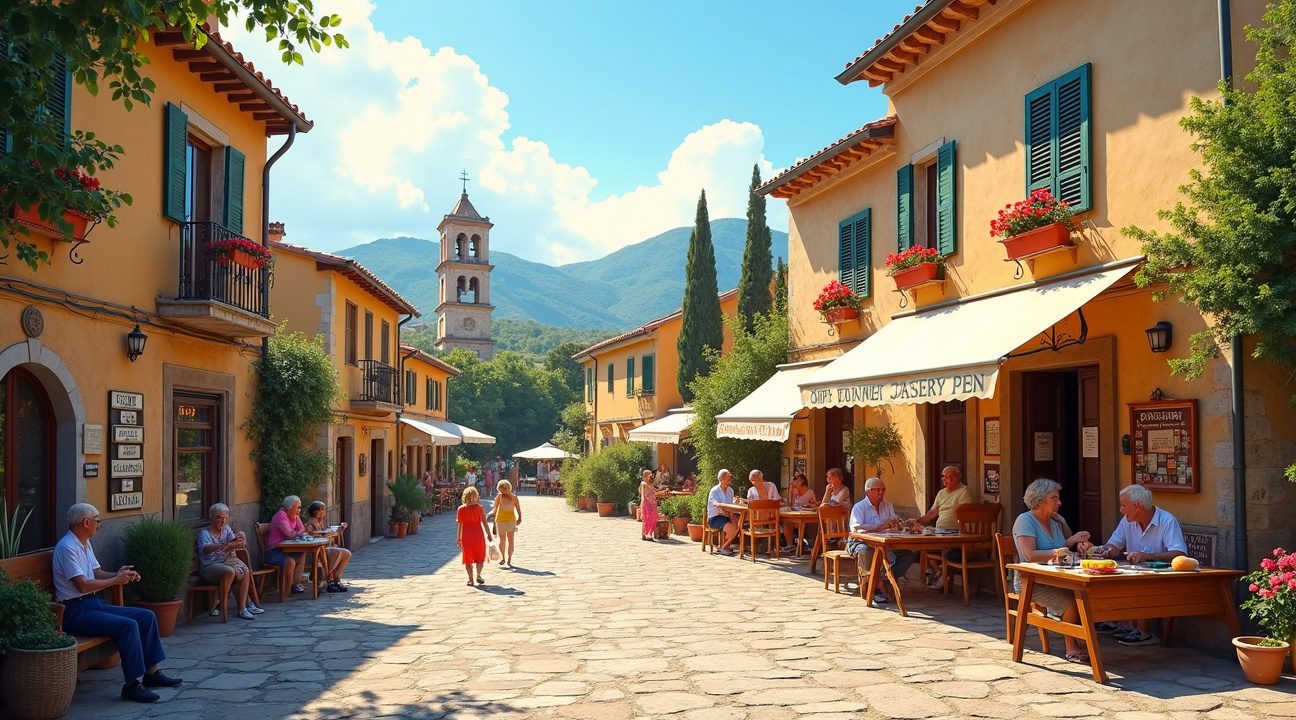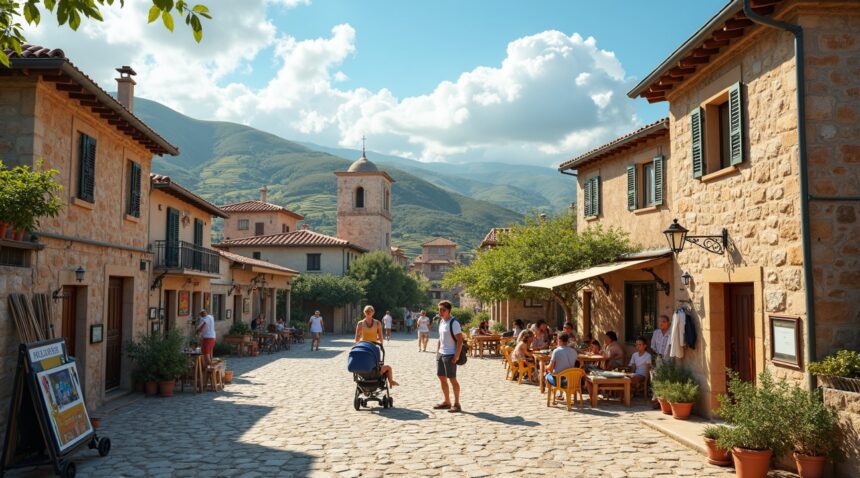The Sardinian government has unveiled a bold €15 million initiative for 2025, encouraging individuals to relocate to its lesser-populated towns by offering attractive financial incentives that form part of a broader €45 million campaign to revitalize rural communities.
Key Takeaways
- Grant amount: Up to €15,000 (approximately $16,200) in non-repayable funding to assist with property purchase or renovation, covering up to 50% of total qualified expenses.
- Eligibility requirements: Applicants must settle permanently in towns with fewer than 3,000 residents (or under 5,000 in special cases) and commit to year-round, full-time residency.
- Application process: Applications are made via the Sardinian Regional Council website and require comprehensive documentation, including proof of property acquisition or renovation and a declaration of permanent residency.
- Additional benefits: Families may receive a €600 monthly newborn bonus, while entrepreneurs can access targeted business grants. The program also includes free Italian language lessons and cultural integration initiatives.
- Financial structure: The program operates on a reimbursement basis. Qualifying applicants must first pay for all eligible expenses out-of-pocket before being reimbursed. Detailed documentation of all expenses is required.
Why This Matters
The initiative reinforces Sardinia’s long-term strategy to combat rural depopulation by investing in its small towns and villages. These grants not only aim to rejuvenate property markets in underpopulated areas but also to incentivize demographic growth and economic vitality through direct support to new residents and business owners.
How to Prepare Your Application
- Identify eligible towns with populations under 3,000 residents.
- Secure a property and ensure it meets the grant qualification standards.
- Gather required documentation, including residency agreements and renovation estimates or purchase contracts.
- Visit the official Sardinia government website to complete the application process.
- Maintain records of all expenses for reimbursement submission.
This program marks a significant opportunity for those seeking a slower-paced lifestyle within a vibrant and culturally rich environment like Sardinia, while contributing to the revitalization of its beautiful rural towns.
Sardinia Offers Up to €15,000 to Move to Small Towns
The Sardinian government has launched an ambitious financial incentive program that provides substantial grants to attract new residents to struggling rural communities. This initiative is particularly compelling because it offers up to €15,000 (approximately $16,200) in non-repayable funding to individuals willing to relocate to designated small towns across the island.
Qualifying for this generous grant comes with specific requirements that potential applicants must understand clearly. Towns eligible for the program typically maintain populations under 3,000 residents, though certain circumstances may extend eligibility to communities with up to 5,000 inhabitants. This population threshold ensures the funding reaches areas most affected by rural depopulation trends.
The financial assistance isn’t simply handed over as cash — recipients must use the grant money specifically for purchasing or renovating residential property within their chosen town. The funding covers up to 50% of total property costs, which significantly reduces the financial burden of relocating. This structure ensures the money directly contributes to local economic development while helping newcomers establish permanent roots in their new communities.
Commitment Requirements and Program Scale
Recipients must make a serious long-term commitment to their new location by living in the purchased or renovated property full-time as permanent residents. This requirement prevents the program from becoming a vehicle for second-home purchases or temporary relocations that wouldn’t address depopulation concerns.
The 2025 program demonstrates the regional government’s substantial commitment to this initiative, with several key funding details:
- €15 million allocated specifically for 2025 grants
- Target approval of over 3,000 individual grants throughout the year
- Part of a larger €45 million regional strategy addressing rural depopulation
- Focus on combating population decline in inland and rural areas
This generous funding represents just one component of Sardinia’s comprehensive approach to revitalizing its struggling communities. The broader €45 million strategy tackles multiple aspects of rural decline, making the relocation grants part of a coordinated effort rather than an isolated program.
Successful applicants often combine this grant with other regional incentives and European Union funding opportunities available for rural development. The program’s structure makes it particularly attractive for remote workers, retirees, or entrepreneurs looking to establish businesses in less crowded environments while maintaining quality of life standards.
The initiative addresses a critical demographic challenge facing many Italian regions, where young people migrate to urban centers for employment opportunities, leaving aging populations in rural areas. By offering substantial financial incentives, Sardinia hopes to reverse this trend and inject new energy into communities that have experienced decades of population decline.
Property renovation projects funded through these grants often contribute to preserving traditional Sardinian architecture while modernizing homes for contemporary living standards. European destinations like Sardinia benefit significantly when historical properties receive careful restoration that maintains cultural character while improving habitability.
The program’s success will likely influence similar initiatives across other Italian regions facing comparable demographic challenges. Early indicators suggest strong interest from international applicants, particularly those seeking lifestyle changes in Mediterranean settings with lower living costs compared to major European cities.
Potential applicants should note that the competitive nature of the program means early preparation and documentation will be essential. The substantial funding allocation and ambitious target of over 3,000 grants suggest the regional government expects significant demand, making thorough preparation crucial for successful applications.

How to Qualify and Apply for Sardinia’s Relocation Grant
The qualification process for Sardinia’s relocation grant involves several strict requirements that potential applicants must understand before making the move. First, I must establish permanent residency (residenza anagrafica) in Sardinia within 18 months of arriving on the island. This residency requirement isn’t just a formality – it means making Sardinia my primary home rather than using it as a vacation property or investment opportunity.
Full-time commitment represents the cornerstone of this program. Italian authorities require complete dedication to living in the selected Sardinian town year-round. This eliminates any possibility of splitting time between Sardinia and another location while receiving grant benefits. The program specifically targets individuals willing to contribute to local communities as permanent residents.
Application Process and Required Documentation
Applications must be submitted through the official Sardinian Regional Council website, which serves as the central portal for all grant-related procedures. The documentation requirements include comprehensive proof of home purchase or detailed plans for renovation work on an existing property. These documents must clearly demonstrate the financial investment being made in Sardinian real estate.
Proof of residency documentation forms another critical component of the application. I’ll need to provide official records showing my commitment to establishing Sardinia as my primary residence. For non-EU nationals, particularly Americans interested in the program, an additional step involves securing a long-term residence permit before applying for the grant.
The financial structure of this grant differs significantly from common misconceptions. Rather than receiving a flat €15,000 payment, the awarded amount directly corresponds to documented expenses incurred during the home purchase or renovation process. This means I must maintain detailed records of all qualifying expenditures, including:
- Purchase contracts
- Renovation receipts
- Related housing costs
Americans and other non-EU citizens face additional bureaucratic steps that can extend the overall timeline. Securing the necessary long-term residence permit often requires several months of processing time, so planning ahead becomes essential for successful participation in the program.
Documentation preparation should begin well before arriving in Sardinia. Having all required paperwork translated into Italian and properly authenticated can prevent delays during the application review process. The grant committee evaluates applications based on completeness and compliance with program requirements, making attention to detail crucial for approval.
For those considering solo travel adventures, Sardinia offers an excellent opportunity to combine relocation incentives with personal exploration goals.
Additional Benefits Beyond the Housing Grant
Sardinia’s relocation incentive extends far beyond simple housing assistance, creating a comprehensive package that makes the transition both financially viable and culturally enriching. I’ve discovered that the Italian government has crafted these additional benefits to ensure newcomers don’t just survive but truly thrive in their new Mediterranean environment.
Financial Support for Families and Entrepreneurs
Families considering this relocation opportunity receive substantial ongoing support through a €600 monthly newborn bonus. According to Resolution 30/52 of June 2025, this payment applies to each child born, adopted, or fostered while living in eligible towns with populations up to 5,000 people. This benefit transforms the financial landscape for young families, making child-rearing significantly more affordable in these rural communities.
Aspiring entrepreneurs also benefit from dedicated business support measures. The program includes:
- Non-repayable grants for new business ventures in participating communities
- Tax credits designed to offset startup costs and operational expenses
- Priority consideration for business licenses and permits in rural development zones
- Access to local business mentorship programs and networking opportunities
These entrepreneurial incentives create genuine pathways for economic independence, allowing newcomers to establish sustainable livelihoods while contributing to local economic revitalization.
Cultural Integration and Lifestyle Advantages
Many participating villages recognize that successful integration requires more than financial assistance. Local communities frequently provide subsidized or completely free Italian language classes, ensuring newcomers can communicate effectively with neighbors and participate fully in community life. Cultural immersion activities help bridge the gap between traditional Sardinian customs and modern lifestyle expectations.
Regular social events create natural opportunities for building relationships and understanding local traditions. These gatherings often center around food festivals, traditional craft workshops, and seasonal celebrations that have defined Sardinian culture for centuries.
Beyond these structured programs, residents gain access to extraordinary lifestyle benefits that money simply can’t buy elsewhere. Sardinia’s Mediterranean climate provides year-round outdoor living opportunities, with mild winters and warm, dry summers perfect for those seeking solo travel adventures or family exploration.
The island’s culinary scene represents another compelling advantage. Local cuisine features fresh seafood, artisanal cheeses, and world-renowned wines produced in small-batch vineyards. Residents often find themselves invited to family dinners where traditional recipes pass between generations, creating authentic cultural connections that extend far beyond tourist experiences.
Sardinia’s natural beauty provides daily inspiration, from pristine beaches rivaling those found among UK’s finest coastal destinations to rugged mountain landscapes perfect for hiking and outdoor recreation. The island’s relatively untouched environment offers a stark contrast to crowded urban centers, providing space for personal reflection and genuine connection with nature.
Community traditions remain vibrantly alive in these smaller towns, where neighbors still gather in central piazzas for evening conversations and local festivals bring entire villages together. This social fabric creates support networks that many urban dwellers haven’t experienced since childhood, fostering genuine belonging rather than mere residence.
The combination of financial incentives, cultural support, and natural advantages creates a relocation package that addresses both practical concerns and quality-of-life aspirations. For individuals or families ready to embrace a different pace of life while maintaining modern conveniences, Sardinia’s comprehensive approach offers compelling reasons to seriously consider this Mediterranean opportunity.

How Sardinia Compares to Other Italian Relocation Programs
Italy has embraced the concept of paying people to relocate across multiple regions, each offering distinct incentives to address specific demographic challenges. Sardinia’s approach represents just one piece of a larger national strategy to revitalize struggling communities.
Regional Variations in Incentives
Several Italian regions have developed compelling relocation packages that rival Sardinia’s offerings:
- Tuscany provides up to €30,000 for home renovations in selected mountain areas, targeting regions that have experienced significant population decline.
- Calabria takes a different approach by offering up to €30,000 to new residents who also commit to starting a business in the area, though this program includes additional criteria such as being aged under 40.
- Puglia’s town of Presicce has created perhaps the most comprehensive package, providing €30,000 toward the purchase of homes built before 1991 and sweetening the deal with an extra €1,000 newborn bonus.
These varied approaches demonstrate how different regions have adapted their strategies to address local needs while competing for new residents.
Sardinia’s Unique Focus
What sets Sardinia apart from these other Italian relocation programs is its specific focus on increasing population in rural and inland villages experiencing demographic decline. While other regions emphasize business development or property renovation, Sardinia prioritizes pure population growth in areas where young people have migrated to cities or abroad.
This demographic-focused approach makes Sardinia’s program particularly attractive to remote workers and retirees who don’t necessarily need to establish local businesses. The island’s emphasis on repopulating specific villages rather than entire regions also means potential residents can expect more concentrated community-building efforts. Unlike programs that spread incentives across larger geographic areas, Sardinia’s targeted village approach creates opportunities for newcomers to make meaningful impacts in small, tight-knit communities.
The strategic differences between these programs reflect each region’s unique challenges and goals, with Sardinia positioning itself as the ideal destination for those seeking authentic rural Italian living rather than urban entrepreneurship or renovation projects.
What Life Actually Looks Like in Sardinia’s Small Towns
I’ve discovered that settling into one of Sardinia’s historic villages means stepping into a completely different rhythm of existence. The program specifically targets charming settlements where centuries-old stone buildings line narrow cobblestone streets, and where ancient traditions still shape daily routines. These aren’t the bustling coastal areas that attract millions of tourists each summer – they’re authentic communities where locals still gather in the central piazza each evening and where family-run businesses have operated for generations.
Daily Life and Community Integration
Living in these villages requires adapting to a pace that prioritizes relationships over productivity. I find that residents typically start their days early, with local markets opening before dawn and cafes serving as informal community centers throughout the morning. The aging population creates unique dynamics where newcomers often become integral to maintaining essential services and cultural traditions that might otherwise disappear.
These communities operate on deep-rooted values that emphasize mutual support and collective responsibility. Neighbors check on elderly residents, children play freely in the streets, and communal celebrations mark religious holidays and seasonal changes. For those considering this lifestyle, it means participating in village festivals, supporting local artisans, and potentially learning the Sardinian dialect that many older residents still speak fluently.
The economic revival aspect focuses heavily on encouraging small business development, creating opportunities for newcomers to establish restaurants, artisan workshops, or agricultural ventures. I’ve observed that successful integration often involves contributing to the local economy while respecting established social hierarchies and customs. Remote workers find reliable internet connections in most villages, though they must balance professional demands with community expectations for participation in local life.
This rural Italian experience differs dramatically from popular European destinations because it demands genuine commitment to becoming part of a tight-knit community. The slower lifestyle means accepting that services operate on flexible schedules, that bureaucratic processes take time, and that personal relationships often matter more than formal procedures. For individuals seeking authentic cultural immersion, these villages offer unparalleled opportunities to experience traditional Mediterranean life while contributing to the preservation of historic communities.

Critical Financial Requirements You Need to Know
The Italian grant system operates as a reimbursement program rather than direct financial assistance, creating specific obligations that applicants must understand before committing. I’ve found that many potential applicants underestimate the upfront financial responsibility required to participate successfully in this initiative.
Understanding the Reimbursement Structure
The program functions through a detailed expense verification process that demands comprehensive documentation. Applicants must provide receipts, contracts, and proof of payment for all qualifying housing-related expenses before receiving any reimbursement. The 50% coverage limit means that for every euro spent on eligible costs, applicants can only recover half through the program.
Financial preparation becomes crucial since participants must cover the full cost of their relocation expenses initially. The grant covers various housing-related expenses, but applicants should budget for:
- Property purchase or renovation costs
- Legal fees and administrative expenses
- Moving and transportation costs
- Initial setup and utility connection fees
- Temporary accommodation during the transition period
The time-sensitive nature of funding creates additional pressure for applicants to act quickly when application windows open. Regional authorities determine fund availability based on annual budget allocations, making timing a critical factor in successful applications. Those interested in European relocation opportunities should monitor these windows carefully.
Funding levels can fluctuate throughout the year based on demand and regional budget constraints. The maximum reimbursement amount isn’t guaranteed for all applicants, even those who meet the basic eligibility criteria. Priority often goes to applications submitted early in the funding cycle or those demonstrating the strongest commitment to long-term residency.
Program criteria may evolve as Italian authorities assess the initiative’s effectiveness and adjust requirements accordingly. Changes could affect everything from eligible expense categories to maximum reimbursement amounts. Smart applicants maintain financial flexibility to adapt to potential program modifications without jeopardizing their relocation plans.
The reality of upfront costs extends beyond the initial 50% contribution requirement. Applicants often discover additional expenses during the relocation process that fall outside the program’s scope. Emergency repairs, unexpected legal complications, or market fluctuations can quickly inflate total costs beyond original estimates.
Financial institutions may not always recognize the grant as guaranteed income when evaluating loan applications for property purchases. This limitation forces many applicants to secure financing based solely on their existing financial resources rather than expected reimbursements. Banks typically require proof of funds covering the full purchase amount before approving mortgages.
Documentation requirements create their own costs through translation services, legal consultations, and administrative fees. The bureaucratic process can extend over several months, requiring sustained financial commitment without immediate returns. Some applicants find the administrative burden more expensive than initially anticipated.
Regional variations in property costs across Sardinia significantly impact the practical value of the 50% reimbursement rate. Coastal areas command premium prices that make the grant less impactful relative to total expenses. Inland villages offer better value propositions but may lack infrastructure or amenities that some relocators require.
Currency fluctuations affect international applicants who must convert foreign earnings to euros for property transactions. Exchange rate variations can effectively reduce the grant’s purchasing power for non-EU residents, adding another layer of financial uncertainty to the process.
I recommend maintaining a financial cushion of at least 25% above projected costs to account for unexpected expenses and potential delays in reimbursement processing. This buffer helps ensure successful completion of the relocation process regardless of minor complications or program adjustments that may arise during the application period.
Sources:
Idealista – “Sardinia Depopulation Incentives 2025: €600 Newborn Bonus, Housing Grants and More”
AFAR – Article on countries that will pay Americans to relocate
Schiff Sovereign – “Relocation Grants: Get Paid to Move to Italy in 2023”
International Living – Article on opportunities to get paid to move to Europe
Prince EA – “13 Italian Villages That Will Pay You Up to $30,000 to Move There”
Strictly Sardinia – Article on getting paid to move to Sardinia
The Economic Times – “Sardinia, Italy: 17 Places Around the World That Will Pay You to Move In”


